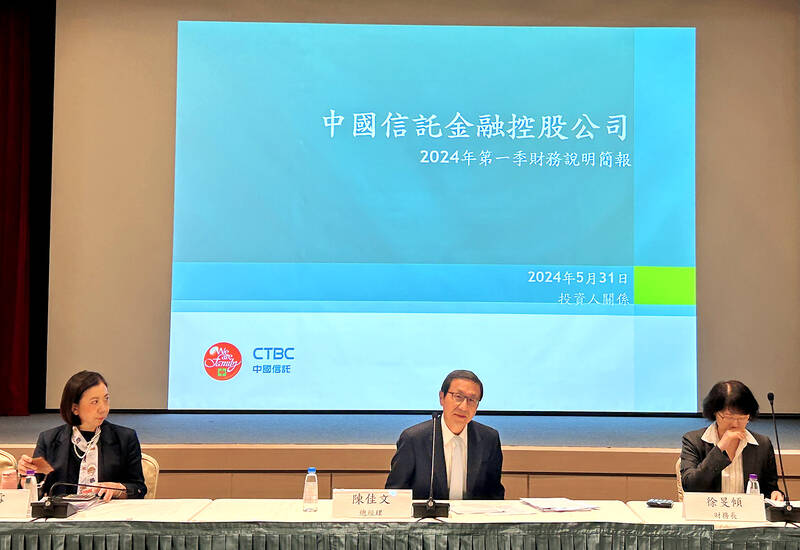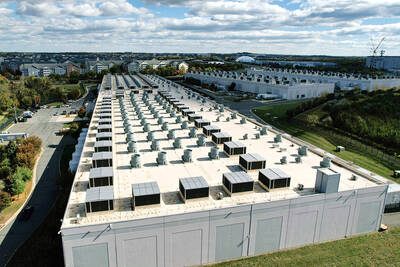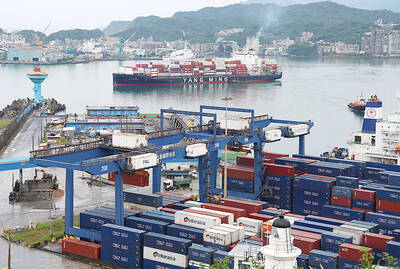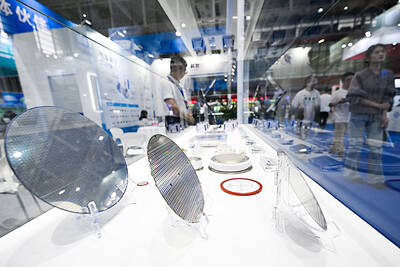CTBC Financial Holding Co (中信金) is looking to grow its profitability this year by double percentage points from last year on the back of an improvement in banking and life insurance operations.
CTBC Financial president James Chen (陳佳文) shared the positive guidance during an investors’ conference in Taipei, after first-quarter income spiked 61 percent year-on-year to NT$20.92 billion (US$645.28 million), or earnings of NT$1.07 per share.
“We’re cautiously optimistic that earnings this year would make record again so that the company can distribute higher cash dividends next year,” Chen said.

Photo: CNA
The conglomerate said it plans to issue NT$1.8 per share in cash dividends based on last year’s profit once the general shareholders’ meeting on June 14 gives the go-ahead.
Main subsidiary CTBC Bank (中國信託銀行) posted a net income of NT$12.1 billion in the January-to-March period, suggesting a 7 percent advance from a year earlier.
Banking operations were stable, but fee income from wealth management, credit card payment, corporate financing and trust management services swelled from 23 percent to 40 percent, Chen said.
Surges in the TAIEX lent support to wealth management, he said.
The local bourse’s pullback this week likely had to do with profit-taking pressures on the part of institutional investors, as the price-to-earnings ratio for local shares climbed to a relatively high level of 23, Chen said.
Overseas banking generated 35 percent of overall profit, with branches in Hong Kong, China and Japan seeing strong growth in general, he said.
Taiwan Life Insurance Co (台灣人壽) emerged as another main profit driver last quarter by realizing capital gains from its share holdings, although the diminishing chance of rate cuts by the US Federal Reserve weighs on its bond positions, Chen said.
The life insurer is poised to benefit from the dividend season between this month and August, when major listed Taiwanese firms distribute cash and stock dividends from the previous year’s earnings, he said.
The group’s securities and fund houses also recorded income growths of double percentage points, as Taiwanese investors aggressively raised stakes in exchange-traded funds and helped boost stock turnover, Chen said.
Chen also commented on the group’s alleged interest in acquiring Shin Kong Financial Holding Co (新光金) for the first time, saying that the two sides have not made any contact on the issue.
The group has a mergers and acquisitions (M&A) team that would make its move when opportunities arise, Chen said.
A big, healthy bank would be an ideal M&A target, as it would help CTBC Bank expand its market share, he said, adding that the bank has an 8 percent market share in Taiwan despite being the largest private-run lender.
CTBC Bank does not have enough local branches, which explains why customers at most branches have to wait more than 20 minutes to be served, Chen said, adding that M&A deals would provide a solution.
Increasingly more people are opting to transact online, but in-person services remain necessary for complicated banking activity, he said.

The demise of the coal industry left the US’ Appalachian region in tatters, with lost jobs, spoiled water and countless kilometers of abandoned underground mines. Now entrepreneurs are eyeing the rural region with ambitious visions to rebuild its economy by converting old mines into solar power systems and data centers that could help fuel the increasing power demands of the artificial intelligence (AI) boom. One such project is underway by a non-profit team calling itself Energy DELTA (Discovery, Education, Learning and Technology Accelerator) Lab, which is looking to develop energy sources on about 26,305 hectares of old coal land in

Taiwan’s exports soared 56 percent year-on-year to an all-time high of US$64.05 billion last month, propelled by surging global demand for artificial intelligence (AI), high-performance computing and cloud service infrastructure, the Ministry of Finance said yesterday. Department of Statistics Director-General Beatrice Tsai (蔡美娜) called the figure an unexpected upside surprise, citing a wave of technology orders from overseas customers alongside the usual year-end shopping season for technology products. Growth is likely to remain strong this month, she said, projecting a 40 percent to 45 percent expansion on an annual basis. The outperformance could prompt the Directorate-General of Budget, Accounting and

Netflix on Friday faced fierce criticism over its blockbuster deal to acquire Warner Bros Discovery. The streaming giant is already viewed as a pariah in some Hollywood circles, largely due to its reluctance to release content in theaters and its disruption of traditional industry practices. As Netflix emerged as the likely winning bidder for Warner Bros — the studio behind Casablanca, the Harry Potter movies and Friends — Hollywood’s elite launched an aggressive campaign against the acquisition. Titanic director James Cameron called the buyout a “disaster,” while a group of prominent producers are lobbying US Congress to oppose the deal,

Two Chinese chipmakers are attracting strong retail investor demand, buoyed by industry peer Moore Threads Technology Co’s (摩爾線程) stellar debut. The retail portion of MetaX Integrated Circuits (Shanghai) Co’s (上海沐曦) upcoming initial public offering (IPO) was 2,986 times oversubscribed on Friday, according to a filing. Meanwhile, Beijing Onmicro Electronics Co (北京昂瑞微), which makes radio frequency chips, was 2,899 times oversubscribed on Friday, its filing showed. The bids coincided with Moore Threads’ trading debut, which surged 425 percent on Friday after raising 8 billion yuan (US$1.13 billion) on bets that the company could emerge as a viable local competitor to Nvidia